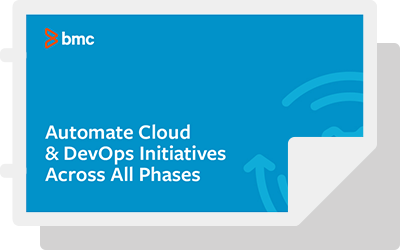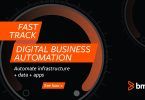On a recent visit to a prospect, while illustrating the value of Control-M, the Head of IT Ops asked: “How are Control-M and Ansible different?”
I’m not sure what drove that question, maybe my description was not clear, or maybe the terminology I used prompted him to think about Ansible. However, since that visit, I’ve heard this question multiple times, and therefore I’ve decided to write a blog to clarify how Control-M and Ansible are different.
About Ansible
Ansible is an open source infrastructure automation tool. According to their own positioning, Ansible is an “IT automation engine (1)” that automates repetitive tasks for people working in IT. What Ansible specifically automates is “cloud provisioning, configuration management, application deployment, intra-service orchestration, and many other IT needs (2)”.
They target the Continuous Delivery (CD) portion of applications life cycle by automatically preparing the desired environment and application stack for developers to deploy, test and run software code without slowing down the Software Development Life Cycle (SDLC).
With the term “orchestration” Ansible refers to scenarios that expand IT automation into a multi-machine process working in concert. Those are scenarios that ensure multiple IT tasks happen in the proper order across multiple machines and can be replicated wherever and whenever needed.
Capital One uses Ansible to automate the entire AWS infrastructure deployment and modeling. They say: “We don’t have to wait for other groups to create things and don’t have to worry for other groups to stop their own code… now we can create an entire stack in few minutes”
About Control-M
Once applications have benefited from Ansible IT automation and pushed out faster to one or more machines, their life in production begins. They need to be orchestrated with other applications and data sources, to deliver a business service or business application, such as:
- End of day close
- Credit approval
- Billing
- Predictive maintenance
The delivery of a business service often requires multiple applications and data sources, across environments from mainframe to cloud, and every step in the process must be invoked at the right time, in the right order, having met the appropriate conditions, for the business service to run accurately at scale. Control-M simplifies the integration and orchestration of such application workflows.
Unlike Ansible, which orchestrates infrastructure tasks, Control-M orchestrates the application and data sources that comprise a business service. Unlike Ansible, which aims at the Continuous Deployment of applications, Control-M drives their execution, visibility and control in production.
Within Control-M, comprehensive capabilities to successfully deliver and monitor business services are provided, including sophisticated orchestration, business level abstraction, traceability and operational insights.
ITAU uses Control-M to launch new digital-first banking services. They accelerate customer online account opening by automatically processing high volume of customer data. They say: “Control-M is a very important tool that we have. If Control-M stops, the bank stops.”
What analysts are saying
Ansible has been positioned as a leader in the Forrester Wave: Infrastructure Automation Platform, Q3 2019, together with Microsoft, VMWare and BMC (TrueSight, Discovery, Cloud Lifecycle Management, and Release Lifecycle Management).
Control-M has been named Value Leader – for the 5th time – of the Enterprise Management Associates (EMA) Radar Report for Workload Automation, 2019, together with ASCI, CA Technologies, HelpSystems, InfiniteData, IBM, Redwood and Stonebranch.
IDC positions Ansible and Control-M under two submarkets of “IT Automation and Configuration Management Software”. Red Hat Ansible is ranked as 9th in the Datacenter System and Application Control Software vendors list, with a market share of 3.9% in a $4.8B sized market. Control-M is ranked as 2th in the Workload Management Software Market Shares with a market share of 18.4% in a $2.2B sized market.
Workflow orchestration: IT-centric vs Business-centric
What Control-M and Ansible have in common is they both perform workflow orchestration. But what they orchestrate is different and shapes their characteristics and scopes:
- Ansible orchestration is focused on IT tasks workflows, to support continuous software delivery.
- Control-M orchestration is focused on application workflows, to deliver business services on time, every time.







